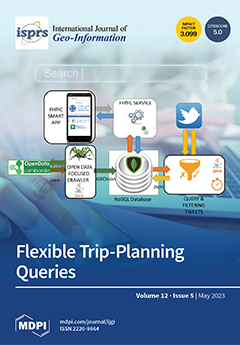Open AccessArticle
A Deep Transfer Learning Toponym Extraction and Geospatial Clustering Framework for Investigating Scenic Spots as Cognitive Regions
by
Chengkun Zhang, Yiran Zhang, Jiajun Zhang, Junwei Yao, Hongjiu Liu, Tao He, Xinyu Zheng, Xingyu Xue, Liang Xu, Jing Yang, Yuanyuan Wang and Liuchang Xu
Cited by 10 | Viewed by 3046
Abstract
In recent years, the Chinese tourism industry has developed rapidly, leading to significant changes in the relationship between people and space patterns in scenic regions. To attract more tourists, the surrounding environment of a scenic region is usually well developed, attracting a large
[...] Read more.
In recent years, the Chinese tourism industry has developed rapidly, leading to significant changes in the relationship between people and space patterns in scenic regions. To attract more tourists, the surrounding environment of a scenic region is usually well developed, attracting a large number of human activities, which creates a cognitive range for the scenic region. From the perspective of tourism, tourists’ perceptions of the region in which tourist attractions are located in a city usually differ from the objective region of the scenic spots. Among them, social media serves as an important medium for tourists to share information about scenic spots and for potential tourists to learn scenic spot information, and it interacts to influence people’s perceptions of the destination image. Extracting the names of tourist attractions from social media data and exploring their spatial distribution patterns is the basis for research on the cognitive region of tourist attractions. This study takes Hangzhou, a well-known tourist city in China, as a case study to explore the human cognitive region of its popular scenic spots. First, we propose a Chinese tourist attraction name extraction model based on RoBERTa-BiLSTM-CRF to extract the names of tourist attractions from social media data. Then, we use a multi-distance spatial clustering method called Ripley’s K to filter the extracted tourist attraction names. Finally, we combine road network data and polygons generated using the chi-shape algorithm to construct the vague cognitive regions of each scenic spot. The results show that the classification indicators of our proposed tourist attraction name extraction model are significantly better than those of previous toponym extraction models and algorithms (precision = 0.7371, recall = 0.6926, F1 = 0.7141), and the extracted vague cognitive regions of tourist attractions also generally conform to people’s habitual cognition.
Full article
►▼
Show Figures





